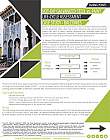A Victory Over Paint for Galvanizing
This report explores several fully hot-dip galvanized bridges in Ashtabula County, Ohio. (Steel Monthly, July 1991), 1 page
Not for sale. Available for Download Only.
View Details »











